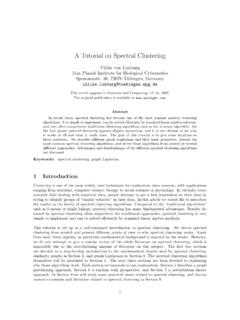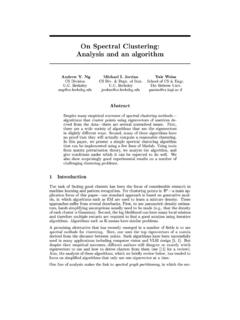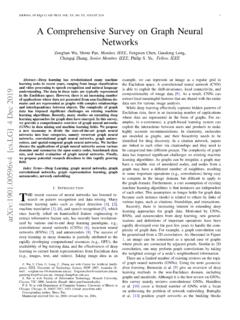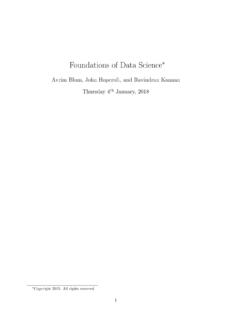Transcription of Variational Autoencoder based Anomaly Detection using ...
1 SNU Data Mining Center 2015-2 Special Lecture on IE. Variational Autoencoder based Anomaly Detection using Reconstruction Probability Jinwon An Sungzoon Cho December 27, 2015. Abstract We propose an Anomaly Detection method using the reconstruction probability from the Variational Autoencoder . The reconstruction probability is a probabilistic measure that takes into account the variability of the distribution of variables. The reconstruction probability has a theoretical background making it a more principled and objective Anomaly score than the reconstruction error, which is used by Autoencoder and principal components based Anomaly Detection methods.
2 Experimental results show that the proposed method outper- forms Autoencoder based and principal components based methods. Utilizing the generative characteristics of the Variational Autoencoder enables deriving the reconstruction of the data to analyze the underlying cause of the Anomaly . 1 Introduction An Anomaly or outlier is a data point which is significantly different from the remaining data. Hawkins defined an Anomaly as an observation which deviates so much from the other observa- tions as to arouse suspicions that it was generated by a different mechanism [5]. Analyzing and detecting anomalies is important because it reveals useful information about the characteristics of the data generation process.
3 Anomaly Detection is applied in network intrusion Detection , credit card fraud Detection , sensor network fault Detection , medical diagnosis and numerous other fields [3]. Among many Anomaly Detection methods, spectral Anomaly Detection techniques try to find the lower dimensional embeddings of the original data where anomalies and normal data are expected to be separated from each other. After finding those lower dimensional embeddings, they are brought back to the original data space which is called the reconstruction of the original data. By reconstructing the data with the low dimension representations, we expect to obtain the true nature of the data, without uninteresting features and noise.
4 Reconstruction error of a data point, which is the error between the original data point and its low dimensional reconstruction, is used as an Anomaly score to detect anomalies. Principal components analysis (PCA) based methods belong to this method of detecting anomalies [3]. With the advent of deep learning, autoencoders are also used to perform dimension reduction by stacking up layers to form deep autoencoders. By reducing the number of units in the hidden layer, it is expected that the hidden units will extract features that well represent the data. Moreover, by stacking autoencoders we can apply dimension reduction in a hierarchical manner, obtaining more abstract features in higher hidden layers leading to a better reconstruction of the data.
5 In this study we propose an Anomaly Detection method using Variational autoencoders (VAE). [8]. A Variational Autoencoder is a probabilistic graphical model that combines Variational inference with deep learning. Because VAE reduces dimensions in a probabilistically sound way, theoretical foundations are firm. The advantage of a VAE over an Autoencoder and a PCA is that it provides a probability measure rather than a reconstruction error as an Anomaly score, which we will call the reconstruction probability. Probabilities are more principled and objective than reconstruction errors and does not require model specific thresholds for judging anomalies.
6 2 Background Anomaly Detection Anomaly Detection methods can be broadly categorized in to statistical, proximity based , and deviation based [1]. Statistical Anomaly Detection assumes that data is modeled from a specified probability distribution. Parametric models such as mixture of Gaussians or Nonparametric models such as kernel density estimation can be used to define a probability distribution. A data point is defined as an Anomaly if the probability of it being generated from the model is below a certain threshold. The advantage of such models is that it gives out probability as the decision rule for judging anomalies, which is objective and theoretically justifiable.
7 Proximity based Anomaly Detection assumes that anomalous data are isolated from the ma- jority of the data. There are three ways in modeling anomalies in this way, which are clustering based , density based , and distance based . For clustering based Anomaly Detection , a clustering algorithm is applied to the data to identify dense regions or clusters that are present in the data. Next, the relationships of the data points to each cluster is evaluated to form an Anomaly score. Such criteria include distance to cluster centroids and the size of the closest cluster. If the distance to cluster centroids is above a threshold or the size of the closest cluster is below 2.
8 A threshold, the data point is defined as an Anomaly . Density based Anomaly Detection define anomalies as data points that lie in sparse regions of the data. For example, if the number of data points within a local region of a data point is below a threshold, it is defined as an Anomaly . Distance based Anomaly Detection uses measurements that are related to the neighboring data points of a given data point. K-nearest neighbor distances can be used in such a way where data points with large k-nearest neighbor distances are defined as anomalies. Deviation based Anomaly Detection is mainly based on spectral Anomaly Detection , which uses reconstruction errors as Anomaly scores.
9 The first step is to reconstruct the data using dimension reduction methods such as principal components analysis or autoencoders. Reconstructing the input using k-most significant principal components and measuring the difference between its original data point and the reconstruction leads to the reconstruction error which can be used as an Anomaly score. Data points with high reconstruction error are defined as anomalies. Autoencoder and Anomaly Detection An Autoencoder is a neural network that is trained by unsupervised learning, which is trained to learn reconstructions that are close to its original input. An Autoencoder is composed of two parts, an encoder and a decoder.
10 A neural network with a single hidden layer has an encoder and decoder as in equation (1) and equation (2), respectively. W and b is the weight and bias of the neural network and is the nonlinear transformation function. h = (Wxh x + bxh ) (1). z = (Whx h + bhx ) (2). kx zk (3). The encoder in equation (1) maps an input vector x to a hidden representation h by a an affine mapping following a nonlinearity. The decoder in equation (2) maps the hidden representation h back to the original input space as a reconstruction by the same transformation as the en- coder. The difference between the original input vector x and the reconstruction z is called the reconstruction error as in equation (3).





